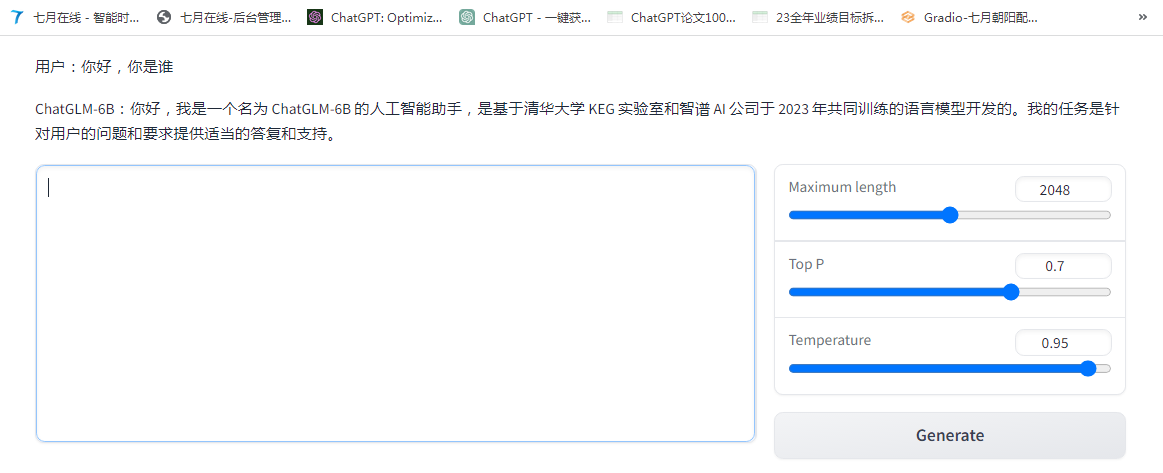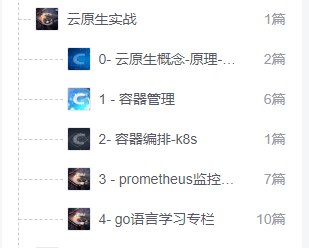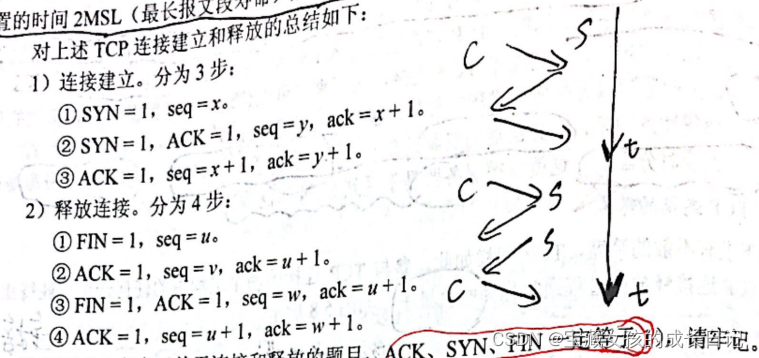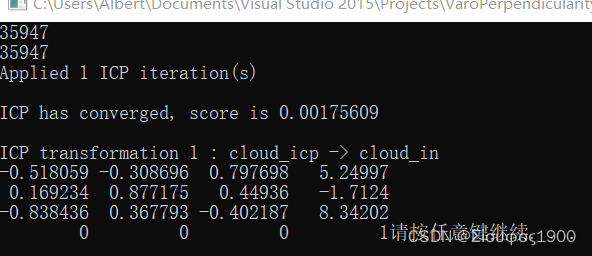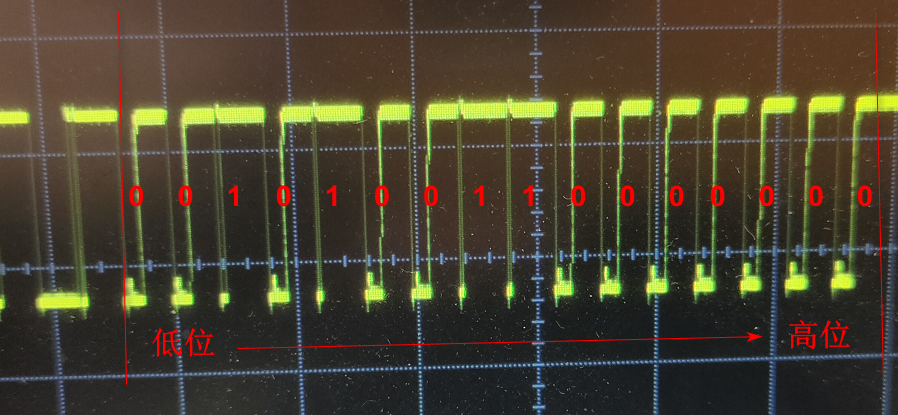问题描述
配置切面,但未切到目标类上
切面类
@Component
@Aspect
public class ControllerAspect {
//@Pointcut("execution(* com.yzk.learn.springbootsecurity.controller.UserController.info(..))")
@Pointcut("execution(* com.learn..*.controller.*.*(..))")
//@Pointcut("@annotation(org.springframework.web.bind.annotation.GetMapping)")
public void around(){
}
@Around("around()")
public Object doAround(ProceedingJoinPoint proceedingJoinPoint) throws Throwable {
try{
Object proceed = proceedingJoinPoint.proceed();
return proceed;
}catch (Exception e){
e.printStackTrace();
}
return null;
}
}
目标类
@RestController
@RequestMapping("/user")
@Slf4j
public class UserController extends ApiController {
@GetMapping("/info")
public String info(HttpSession session) {
return null;
}
源码分析
因代码复杂且分支多,目前截图的顺序是按照从调用链的末端开始,是为了更好的能debug及找到调用线头,不被别的分支代码影响,debug时可以按照文章顺序,非debug可以从后往前看,从后往前是正常的调用顺序
SignaturePattern类
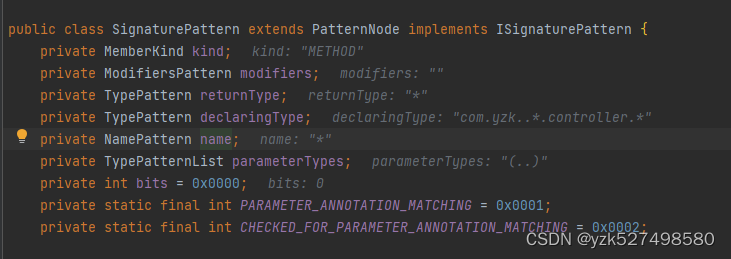
JoinPointSignature aMethod 目标类

World world 切面类及表达式
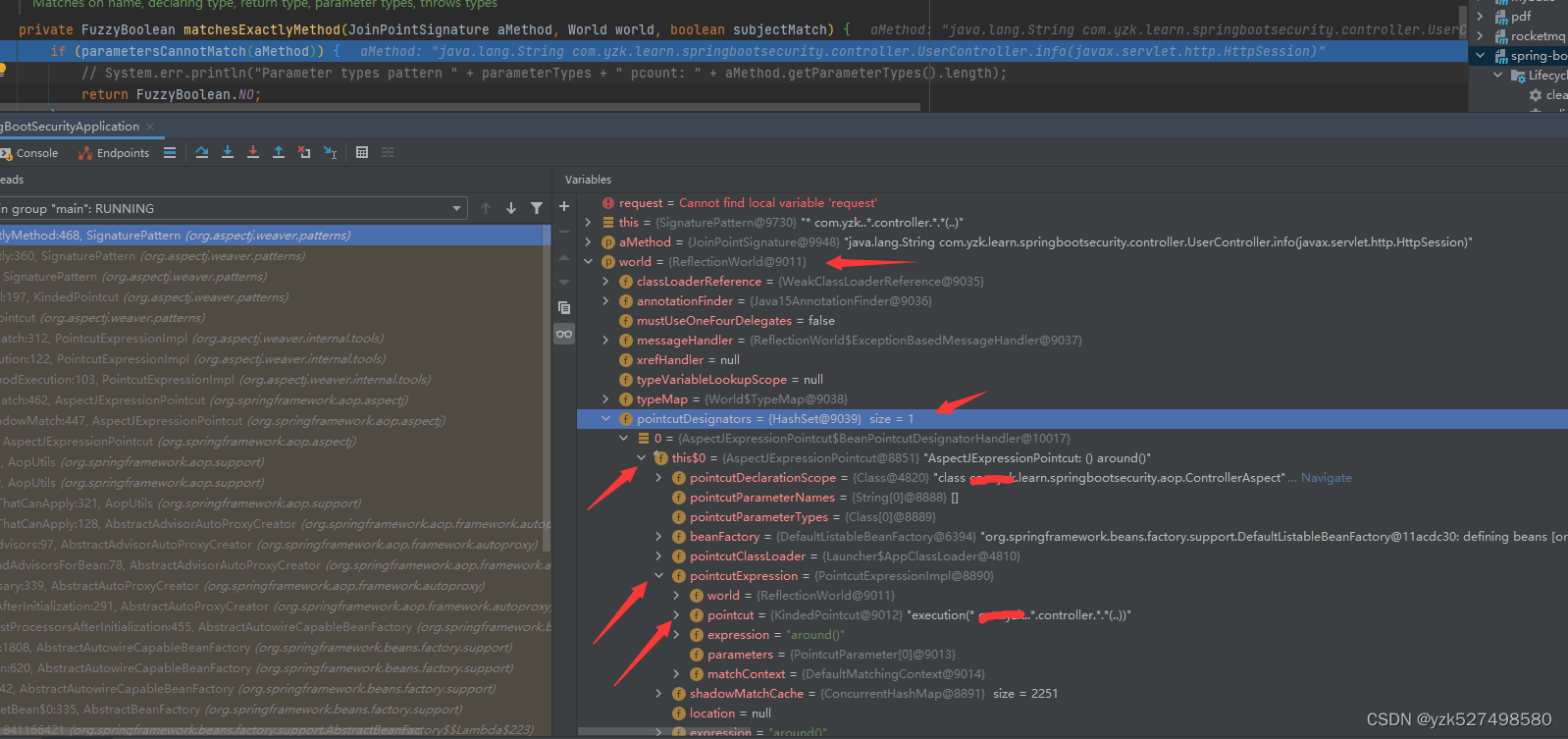
private FuzzyBoolean matchesExactlyMethod(JoinPointSignature aMethod, World world, boolean subjectMatch) {
//判断参数是否匹配
if (parametersCannotMatch(aMethod)) {
// System.err.println("Parameter types pattern " + parameterTypes + " pcount: " + aMethod.getParameterTypes().length);
return FuzzyBoolean.NO;
}
// OPTIMIZE only for exact match do the pattern match now? Otherwise defer it until other fast checks complete?
//判断方法名称是否匹配 此处name为* aMethod.getName为info
if (!name.matches(aMethod.getName())) {
return FuzzyBoolean.NO;
}
// Check the throws pattern
//判断异常类型是否匹配
if (subjectMatch && !throwsPattern.matches(aMethod.getExceptions(), world)) {
return FuzzyBoolean.NO;
}
// '*' trivially matches everything, no need to check further
//判断路径是否匹配
if (!declaringType.isStar()) {
if (!declaringType.matchesStatically(aMethod.getDeclaringType().resolve(world))) {
return FuzzyBoolean.MAYBE;
}
}
// '*' would match any return value
//判断返回值是否匹配
if (!returnType.isStar()) {
boolean b = returnType.isBangVoid();
if (b) {
String s = aMethod.getReturnType().getSignature();
if (s.length() == 1 && s.charAt(0) == 'V') {
// it is void, so not a match
return FuzzyBoolean.NO;
}
} else {
if (returnType.isVoid()) {
String s = aMethod.getReturnType().getSignature();
if (s.length() != 1 || s.charAt(0) != 'V') {
// it is not void, so not a match
return FuzzyBoolean.NO;
}
} else {
if (!returnType.matchesStatically(aMethod.getReturnType().resolve(world))) {
// looking bad, but there might be parameterization to consider...
if (!returnType.matchesStatically(aMethod.getGenericReturnType().resolve(world))) {
// ok, it's bad.
return FuzzyBoolean.MAYBE;
}
}
}
}
}
// The most simple case: pattern is (..) will match anything
//参数为(..) 匹配所有参数的方法
if (parameterTypes.size() == 1 && parameterTypes.get(0).isEllipsis()) {
return FuzzyBoolean.YES;
}
if (!parameterTypes.canMatchSignatureWithNParameters(aMethod.getParameterTypes().length)) {
return FuzzyBoolean.NO;
}
// OPTIMIZE both resolution of these types and their annotations should be deferred - just pass down a world and do it lower
// down
// ResolvedType[] resolvedParameters = world.resolve(aMethod.getParameterTypes());
ResolvableTypeList rtl = new ResolvableTypeList(world, aMethod.getParameterTypes());
// Only fetch the parameter annotations if the pointcut is going to be matching on them
ResolvedType[][] parameterAnnotationTypes = null;
if (isMatchingParameterAnnotations()) {
parameterAnnotationTypes = aMethod.getParameterAnnotationTypes();
if (parameterAnnotationTypes != null && parameterAnnotationTypes.length == 0) {
parameterAnnotationTypes = null;
}
}
if (!parameterTypes.matches(rtl, TypePattern.STATIC, parameterAnnotationTypes).alwaysTrue()) {
// It could still be a match based on the generic sig parameter types of a parameterized type
if (!parameterTypes.matches(new ResolvableTypeList(world, aMethod.getGenericParameterTypes()), TypePattern.STATIC,
parameterAnnotationTypes).alwaysTrue()) {
return FuzzyBoolean.MAYBE;
// It could STILL be a match based on the erasure of the parameter types??
// to be determined via test cases...
}
}
// check that varargs specifications match
if (!matchesVarArgs(aMethod, world)) {
return FuzzyBoolean.MAYBE;
}
// passed all the guards..
return FuzzyBoolean.YES;
}
在else if (kind == Member.METHOD) 处调用上一个方法
private FuzzyBoolean matchesExactly(JoinPointSignature aMember, World inAWorld, boolean allowBridgeMethods, boolean subjectMatch) {
// Java5 introduces bridge methods, we match a call to them but nothing else...
if (aMember.isBridgeMethod() && !allowBridgeMethods) {
return FuzzyBoolean.MAYBE;
}
// Only the subject is checked for modifiers
// see http://www.eclipse.org/aspectj/doc/next/adk15notebook/join-point-modifiers.html
if (subjectMatch && !modifiers.matches(aMember.getModifiers())) {
return FuzzyBoolean.NO;
}
FuzzyBoolean matchesIgnoringAnnotations = FuzzyBoolean.YES;
if (kind == Member.STATIC_INITIALIZATION) {
matchesIgnoringAnnotations = matchesExactlyStaticInitialization(aMember, inAWorld);
} else if (kind == Member.FIELD) {
matchesIgnoringAnnotations = matchesExactlyField(aMember, inAWorld);
} else if (kind == Member.METHOD) {
//上个方法调用处
matchesIgnoringAnnotations = matchesExactlyMethod(aMember, inAWorld, subjectMatch);
} else if (kind == Member.CONSTRUCTOR) {
matchesIgnoringAnnotations = matchesExactlyConstructor(aMember, inAWorld);
}
if (matchesIgnoringAnnotations.alwaysFalse()) {
return FuzzyBoolean.NO;
}
// Only the subject is checked for annotations (239441/119749)
// see http://www.eclipse.org/aspectj/doc/next/adk15notebook/join-point-modifiers.html
if (subjectMatch) {
// The annotations must match if specified
if (!matchesAnnotations(aMember, inAWorld).alwaysTrue()) {
return FuzzyBoolean.NO;
} else {
return matchesIgnoringAnnotations;
}
} else {
// Unless they specified any annotation then it is a failure
if (annotationPattern instanceof AnyAnnotationTypePattern) {
return matchesIgnoringAnnotations;
} else {
return FuzzyBoolean.NO;
}
}
// if (subjectMatch && !matchesAnnotations(aMember, inAWorld).alwaysTrue()) {
// return FuzzyBoolean.NO;
// } else {
//
// return matchesIgnoringAnnotations;
// }
}
在FuzzyBoolean matchResult = matchesExactly(aSig, world, allowBridgeMethods, subjectMatch);处调用上一个方法
public boolean matches(Member joinPointSignature, World world, boolean allowBridgeMethods) {
// fail (or succeed!) fast tests...
if (joinPointSignature == null) {
return false;
}
if (kind != joinPointSignature.getKind()) {
return false;
}
if (kind == Member.ADVICE) {
return true;
}
// do the hard work then...
boolean subjectMatch = true;
boolean wantsAnnotationMatch = wantToMatchAnnotationPattern();
JoinPointSignatureIterator candidateMatches = joinPointSignature.getJoinPointSignatures(world);
while (candidateMatches.hasNext()) {
JoinPointSignature aSig = candidateMatches.next();
// System.out.println(aSig);
FuzzyBoolean matchResult = matchesExactly(aSig, world, allowBridgeMethods, subjectMatch);
if (matchResult.alwaysTrue()) {
return true;
} else if (matchResult.alwaysFalse()) {
return false;
}
// if we got a "MAYBE" it's worth looking at the other signatures
// The first signature is the subject signature - and against it we must match modifiers/annotations/throws
// see http://www.eclipse.org/aspectj/doc/next/adk15notebook/join-point-modifiers.html
subjectMatch = false;
// Early exit
if (wantsAnnotationMatch) {
return false;
}
}
return false;
}
KindedPointcut类
在!signature.matches(shadow.getMatchingSignature(), shadow.getIWorld(), this.kind == Shadow.MethodCall)) 处调用上一个方法
protected FuzzyBoolean matchInternal(Shadow shadow) {
if (shadow.getKind() != kind) {
return FuzzyBoolean.NO;
}
if (shadow.getKind() == Shadow.SynchronizationLock && kind == Shadow.SynchronizationLock) {
return FuzzyBoolean.YES;
}
if (shadow.getKind() == Shadow.SynchronizationUnlock && kind == Shadow.SynchronizationUnlock) {
return FuzzyBoolean.YES;
}
if (!signature.matches(shadow.getMatchingSignature(), shadow.getIWorld(), this.kind == Shadow.MethodCall)) {
if (kind == Shadow.MethodCall) {
warnOnConfusingSig(shadow);
// warnOnBridgeMethod(shadow);
}
return FuzzyBoolean.NO;
}
return FuzzyBoolean.YES;
}
Pointcut类
在ret = matchInternal(shadow);处调用上一个方法
public final FuzzyBoolean match(Shadow shadow) {
if (shadow.shadowId == lastMatchedShadowId) {
return lastMatchedShadowResult;
}
FuzzyBoolean ret;
// this next test will prevent a lot of un-needed matching going on....
if (shadow.getKind().isSet(couldMatchKinds())) {
ret = matchInternal(shadow);
} else {
ret = FuzzyBoolean.NO;
}
lastMatchedShadowId = shadow.shadowId;
lastMatchedShadowResult = ret;
return ret;
}
PointcutExpressionImpl类
在org.aspectj.util.FuzzyBoolean match = pointcut.match(forShadow);处调用上一个方法
private ShadowMatchImpl getShadowMatch(Shadow forShadow) {
org.aspectj.util.FuzzyBoolean match = pointcut.match(forShadow);
Test residueTest = Literal.TRUE;
ExposedState state = getExposedState();
if (match.maybeTrue()) {
residueTest = pointcut.findResidue(forShadow, state);
}
ShadowMatchImpl sm = new ShadowMatchImpl(match, residueTest, state, parameters);
sm.setMatchingContext(this.matchContext);
return sm;
}
在ShadowMatchImpl sm = getShadowMatch(s);处调用上一个方法
private ShadowMatch matchesExecution(Member aMember) {
Shadow s = ReflectionShadow.makeExecutionShadow(world, aMember, this.matchContext);
ShadowMatchImpl sm = getShadowMatch(s);
sm.setSubject(aMember);
sm.setWithinCode(null);
sm.setWithinType(aMember.getDeclaringClass());
return sm;
}
在ShadowMatch match = matchesExecution(aMethod);处调用上一个方法
public ShadowMatch matchesMethodExecution(Method aMethod) {
ShadowMatch match = matchesExecution(aMethod);
if (MATCH_INFO && match.maybeMatches()) {
System.out.println("MATCHINFO: method execution match on '" + aMethod + "' for '" + this.expression + "': "
+ (match.alwaysMatches() ? "YES" : "MAYBE"));
}
return match;
}
AspectJExpressionPointcut类
在shadowMatch = obtainPointcutExpression().matchesMethodExecution(methodToMatch);处调用上一个方法
private ShadowMatch getShadowMatch(Method targetMethod, Method originalMethod) {
// Avoid lock contention for known Methods through concurrent access...
ShadowMatch shadowMatch = this.shadowMatchCache.get(targetMethod);
if (shadowMatch == null) {
synchronized (this.shadowMatchCache) {
// Not found - now check again with full lock...
PointcutExpression fallbackExpression = null;
shadowMatch = this.shadowMatchCache.get(targetMethod);
if (shadowMatch == null) {
Method methodToMatch = targetMethod;
try {
try {
shadowMatch = obtainPointcutExpression().matchesMethodExecution(methodToMatch);
}
catch (ReflectionWorldException ex) {
// Failed to introspect target method, probably because it has been loaded
// in a special ClassLoader. Let's try the declaring ClassLoader instead...
try {
fallbackExpression = getFallbackPointcutExpression(methodToMatch.getDeclaringClass());
if (fallbackExpression != null) {
shadowMatch = fallbackExpression.matchesMethodExecution(methodToMatch);
}
}
catch (ReflectionWorldException ex2) {
fallbackExpression = null;
}
}
if (targetMethod != originalMethod && (shadowMatch == null ||
(shadowMatch.neverMatches() && Proxy.isProxyClass(targetMethod.getDeclaringClass())))) {
// Fall back to the plain original method in case of no resolvable match or a
// negative match on a proxy class (which doesn't carry any annotations on its
// redeclared methods).
methodToMatch = originalMethod;
try {
shadowMatch = obtainPointcutExpression().matchesMethodExecution(methodToMatch);
}
catch (ReflectionWorldException ex) {
// Could neither introspect the target class nor the proxy class ->
// let's try the original method's declaring class before we give up...
try {
fallbackExpression = getFallbackPointcutExpression(methodToMatch.getDeclaringClass());
if (fallbackExpression != null) {
shadowMatch = fallbackExpression.matchesMethodExecution(methodToMatch);
}
}
catch (ReflectionWorldException ex2) {
fallbackExpression = null;
}
}
}
}
catch (Throwable ex) {
// Possibly AspectJ 1.8.10 encountering an invalid signature
logger.debug("PointcutExpression matching rejected target method", ex);
fallbackExpression = null;
}
if (shadowMatch == null) {
shadowMatch = new ShadowMatchImpl(org.aspectj.util.FuzzyBoolean.NO, null, null, null);
}
else if (shadowMatch.maybeMatches() && fallbackExpression != null) {
shadowMatch = new DefensiveShadowMatch(shadowMatch,
fallbackExpression.matchesMethodExecution(methodToMatch));
}
this.shadowMatchCache.put(targetMethod, shadowMatch);
}
}
}
return shadowMatch;
}
在return getShadowMatch(targetMethod, method);处调用上一个方法
private ShadowMatch getTargetShadowMatch(Method method, Class<?> targetClass) {
Method targetMethod = AopUtils.getMostSpecificMethod(method, targetClass);
if (targetMethod.getDeclaringClass().isInterface()) {
// Try to build the most specific interface possible for inherited methods to be
// considered for sub-interface matches as well, in particular for proxy classes.
// Note: AspectJ is only going to take Method.getDeclaringClass() into account.
Set<Class<?>> ifcs = ClassUtils.getAllInterfacesForClassAsSet(targetClass);
if (ifcs.size() > 1) {
try {
Class<?> compositeInterface = ClassUtils.createCompositeInterface(
ClassUtils.toClassArray(ifcs), targetClass.getClassLoader());
targetMethod = ClassUtils.getMostSpecificMethod(targetMethod, compositeInterface);
}
catch (IllegalArgumentException ex) {
// Implemented interfaces probably expose conflicting method signatures...
// Proceed with original target method.
}
}
}
return getShadowMatch(targetMethod, method);
}
在ShadowMatch shadowMatch = getTargetShadowMatch(method, targetClass);处调用上一个方法
public boolean matches(Method method, Class<?> targetClass, boolean hasIntroductions) {
obtainPointcutExpression();
ShadowMatch shadowMatch = getTargetShadowMatch(method, targetClass);
// Special handling for this, target, @this, @target, @annotation
// in Spring - we can optimize since we know we have exactly this class,
// and there will never be matching subclass at runtime.
if (shadowMatch.alwaysMatches()) {
return true;
}
else if (shadowMatch.neverMatches()) {
return false;
}
else {
// the maybe case
if (hasIntroductions) {
return true;
}
// A match test returned maybe - if there are any subtype sensitive variables
// involved in the test (this, target, at_this, at_target, at_annotation) then
// we say this is not a match as in Spring there will never be a different
// runtime subtype.
RuntimeTestWalker walker = getRuntimeTestWalker(shadowMatch);
return (!walker.testsSubtypeSensitiveVars() || walker.testTargetInstanceOfResidue(targetClass));
}
}
AopUtils类
在(introductionAwareMethodMatcher != null ?
introductionAwareMethodMatcher.matches(method, targetClass, hasIntroductions) :
methodMatcher.matches(method, targetClass))处调用上一个方法
public static boolean canApply(Pointcut pc, Class<?> targetClass, boolean hasIntroductions) {
Assert.notNull(pc, "Pointcut must not be null");
if (!pc.getClassFilter().matches(targetClass)) {
return false;
}
MethodMatcher methodMatcher = pc.getMethodMatcher();
if (methodMatcher == MethodMatcher.TRUE) {
// No need to iterate the methods if we're matching any method anyway...
return true;
}
IntroductionAwareMethodMatcher introductionAwareMethodMatcher = null;
if (methodMatcher instanceof IntroductionAwareMethodMatcher) {
introductionAwareMethodMatcher = (IntroductionAwareMethodMatcher) methodMatcher;
}
Set<Class<?>> classes = new LinkedHashSet<>();
if (!Proxy.isProxyClass(targetClass)) {
classes.add(ClassUtils.getUserClass(targetClass));
}
classes.addAll(ClassUtils.getAllInterfacesForClassAsSet(targetClass));
for (Class<?> clazz : classes) {
Method[] methods = ReflectionUtils.getAllDeclaredMethods(clazz);
for (Method method : methods) {
if (introductionAwareMethodMatcher != null ?
introductionAwareMethodMatcher.matches(method, targetClass, hasIntroductions) :
methodMatcher.matches(method, targetClass)) {
return true;
}
}
}
return false;
}
在return canApply(pca.getPointcut(), targetClass, hasIntroductions);调用上一个方法
public static boolean canApply(Advisor advisor, Class<?> targetClass, boolean hasIntroductions) {
if (advisor instanceof IntroductionAdvisor) {
return ((IntroductionAdvisor) advisor).getClassFilter().matches(targetClass);
}
else if (advisor instanceof PointcutAdvisor) {
PointcutAdvisor pca = (PointcutAdvisor) advisor;
return canApply(pca.getPointcut(), targetClass, hasIntroductions);
}
else {
// It doesn't have a pointcut so we assume it applies.
return true;
}
}
在canApply(candidate, clazz, hasIntroductions)处调用上一个方法
public static List<Advisor> findAdvisorsThatCanApply(List<Advisor> candidateAdvisors, Class<?> clazz) {
if (candidateAdvisors.isEmpty()) {
return candidateAdvisors;
}
List<Advisor> eligibleAdvisors = new ArrayList<>();
for (Advisor candidate : candidateAdvisors) {
if (candidate instanceof IntroductionAdvisor && canApply(candidate, clazz)) {
eligibleAdvisors.add(candidate);
}
}
boolean hasIntroductions = !eligibleAdvisors.isEmpty();
for (Advisor candidate : candidateAdvisors) {
if (candidate instanceof IntroductionAdvisor) {
// already processed
continue;
}
if (canApply(candidate, clazz, hasIntroductions)) {
eligibleAdvisors.add(candidate);
}
}
return eligibleAdvisors;
}
AbstractAdvisorAutoProxyCreator类
在return AopUtils.findAdvisorsThatCanApply(candidateAdvisors, beanClass);处调用上一个方法
protected List<Advisor> findAdvisorsThatCanApply(
List<Advisor> candidateAdvisors, Class<?> beanClass, String beanName) {
ProxyCreationContext.setCurrentProxiedBeanName(beanName);
try {
return AopUtils.findAdvisorsThatCanApply(candidateAdvisors, beanClass);
}
finally {
ProxyCreationContext.setCurrentProxiedBeanName(null);
}
}
在List eligibleAdvisors = findAdvisorsThatCanApply(candidateAdvisors, beanClass, beanName);处调用上一个方法
protected List<Advisor> findEligibleAdvisors(Class<?> beanClass, String beanName) {
List<Advisor> candidateAdvisors = findCandidateAdvisors();
List<Advisor> eligibleAdvisors = findAdvisorsThatCanApply(candidateAdvisors, beanClass, beanName);
extendAdvisors(eligibleAdvisors);
if (!eligibleAdvisors.isEmpty()) {
eligibleAdvisors = sortAdvisors(eligibleAdvisors);
}
return eligibleAdvisors;
}
在List advisors = findEligibleAdvisors(beanClass, beanName);处调用上一个方法
protected Object[] getAdvicesAndAdvisorsForBean(
Class<?> beanClass, String beanName, @Nullable TargetSource targetSource) {
List<Advisor> advisors = findEligibleAdvisors(beanClass, beanName);
if (advisors.isEmpty()) {
return DO_NOT_PROXY;
}
return advisors.toArray();
}
AbstractAutoProxyCreator类
在Object[] specificInterceptors = getAdvicesAndAdvisorsForBean(bean.getClass(), beanName, null);处调用上一个方法
此处需要关注的地方就是
Object proxy = createProxy(
bean.getClass(), beanName, specificInterceptors, new SingletonTargetSource(bean));
this.proxyTypes.put(cacheKey, proxy.getClass());
生成了相应的代理类
protected Object wrapIfNecessary(Object bean, String beanName, Object cacheKey) {
if (StringUtils.hasLength(beanName) && this.targetSourcedBeans.contains(beanName)) {
return bean;
}
if (Boolean.FALSE.equals(this.advisedBeans.get(cacheKey))) {
return bean;
}
if (isInfrastructureClass(bean.getClass()) || shouldSkip(bean.getClass(), beanName)) {
this.advisedBeans.put(cacheKey, Boolean.FALSE);
return bean;
}
// Create proxy if we have advice.
Object[] specificInterceptors = getAdvicesAndAdvisorsForBean(bean.getClass(), beanName, null);
if (specificInterceptors != DO_NOT_PROXY) {
this.advisedBeans.put(cacheKey, Boolean.TRUE);
Object proxy = createProxy(
bean.getClass(), beanName, specificInterceptors, new SingletonTargetSource(bean));
this.proxyTypes.put(cacheKey, proxy.getClass());
return proxy;
}
this.advisedBeans.put(cacheKey, Boolean.FALSE);
return bean;
}
在return wrapIfNecessary(bean, beanName, cacheKey);处调用上一个方法
public Object postProcessAfterInitialization(@Nullable Object bean, String beanName) {
if (bean != null) {
Object cacheKey = getCacheKey(bean.getClass(), beanName);
if (this.earlyProxyReferences.remove(cacheKey) != bean) {
return wrapIfNecessary(bean, beanName, cacheKey);
}
}
return bean;
}
AbstractAutowireCapableBeanFactory类
在Object current = processor.postProcessAfterInitialization(result, beanName);处调用上一个方法
public Object applyBeanPostProcessorsAfterInitialization(Object existingBean, String beanName)
throws BeansException {
Object result = existingBean;
for (BeanPostProcessor processor : getBeanPostProcessors()) {
Object current = processor.postProcessAfterInitialization(result, beanName);
if (current == null) {
return result;
}
result = current;
}
return result;
}
在wrappedBean = applyBeanPostProcessorsAfterInitialization(wrappedBean, beanName);处调用上一个方法
protected Object initializeBean(String beanName, Object bean, @Nullable RootBeanDefinition mbd) {
if (System.getSecurityManager() != null) {
AccessController.doPrivileged((PrivilegedAction<Object>) () -> {
invokeAwareMethods(beanName, bean);
return null;
}, getAccessControlContext());
}
else {
invokeAwareMethods(beanName, bean);
}
Object wrappedBean = bean;
if (mbd == null || !mbd.isSynthetic()) {
wrappedBean = applyBeanPostProcessorsBeforeInitialization(wrappedBean, beanName);
}
try {
invokeInitMethods(beanName, wrappedBean, mbd);
}
catch (Throwable ex) {
throw new BeanCreationException(
(mbd != null ? mbd.getResourceDescription() : null),
beanName, "Invocation of init method failed", ex);
}
if (mbd == null || !mbd.isSynthetic()) {
wrappedBean = applyBeanPostProcessorsAfterInitialization(wrappedBean, beanName);
}
return wrappedBean;
}
在exposedObject = initializeBean(beanName, exposedObject, mbd);处调用上一个方法
protected Object doCreateBean(String beanName, RootBeanDefinition mbd, @Nullable Object[] args)
throws BeanCreationException {
// Instantiate the bean.
BeanWrapper instanceWrapper = null;
if (mbd.isSingleton()) {
instanceWrapper = this.factoryBeanInstanceCache.remove(beanName);
}
if (instanceWrapper == null) {
instanceWrapper = createBeanInstance(beanName, mbd, args);
}
Object bean = instanceWrapper.getWrappedInstance();
Class<?> beanType = instanceWrapper.getWrappedClass();
if (beanType != NullBean.class) {
mbd.resolvedTargetType = beanType;
}
// Allow post-processors to modify the merged bean definition.
synchronized (mbd.postProcessingLock) {
if (!mbd.postProcessed) {
try {
applyMergedBeanDefinitionPostProcessors(mbd, beanType, beanName);
}
catch (Throwable ex) {
throw new BeanCreationException(mbd.getResourceDescription(), beanName,
"Post-processing of merged bean definition failed", ex);
}
mbd.postProcessed = true;
}
}
// Eagerly cache singletons to be able to resolve circular references
// even when triggered by lifecycle interfaces like BeanFactoryAware.
boolean earlySingletonExposure = (mbd.isSingleton() && this.allowCircularReferences &&
isSingletonCurrentlyInCreation(beanName));
if (earlySingletonExposure) {
if (logger.isTraceEnabled()) {
logger.trace("Eagerly caching bean '" + beanName +
"' to allow for resolving potential circular references");
}
addSingletonFactory(beanName, () -> getEarlyBeanReference(beanName, mbd, bean));
}
// Initialize the bean instance.
Object exposedObject = bean;
try {
populateBean(beanName, mbd, instanceWrapper);
exposedObject = initializeBean(beanName, exposedObject, mbd);
}
catch (Throwable ex) {
if (ex instanceof BeanCreationException && beanName.equals(((BeanCreationException) ex).getBeanName())) {
throw (BeanCreationException) ex;
}
else {
throw new BeanCreationException(
mbd.getResourceDescription(), beanName, "Initialization of bean failed", ex);
}
}
if (earlySingletonExposure) {
Object earlySingletonReference = getSingleton(beanName, false);
if (earlySingletonReference != null) {
if (exposedObject == bean) {
exposedObject = earlySingletonReference;
}
else if (!this.allowRawInjectionDespiteWrapping && hasDependentBean(beanName)) {
String[] dependentBeans = getDependentBeans(beanName);
Set<String> actualDependentBeans = new LinkedHashSet<>(dependentBeans.length);
for (String dependentBean : dependentBeans) {
if (!removeSingletonIfCreatedForTypeCheckOnly(dependentBean)) {
actualDependentBeans.add(dependentBean);
}
}
if (!actualDependentBeans.isEmpty()) {
throw new BeanCurrentlyInCreationException(beanName,
"Bean with name '" + beanName + "' has been injected into other beans [" +
StringUtils.collectionToCommaDelimitedString(actualDependentBeans) +
"] in its raw version as part of a circular reference, but has eventually been " +
"wrapped. This means that said other beans do not use the final version of the " +
"bean. This is often the result of over-eager type matching - consider using " +
"'getBeanNamesForType' with the 'allowEagerInit' flag turned off, for example.");
}
}
}
}
// Register bean as disposable.
try {
registerDisposableBeanIfNecessary(beanName, bean, mbd);
}
catch (BeanDefinitionValidationException ex) {
throw new BeanCreationException(
mbd.getResourceDescription(), beanName, "Invalid destruction signature", ex);
}
return exposedObject;
}
在Object beanInstance = doCreateBean(beanName, mbdToUse, args);处调用上一个方法
@Override
protected Object createBean(String beanName, RootBeanDefinition mbd, @Nullable Object[] args)
throws BeanCreationException {
if (logger.isTraceEnabled()) {
logger.trace("Creating instance of bean '" + beanName + "'");
}
RootBeanDefinition mbdToUse = mbd;
// Make sure bean class is actually resolved at this point, and
// clone the bean definition in case of a dynamically resolved Class
// which cannot be stored in the shared merged bean definition.
Class<?> resolvedClass = resolveBeanClass(mbd, beanName);
if (resolvedClass != null && !mbd.hasBeanClass() && mbd.getBeanClassName() != null) {
mbdToUse = new RootBeanDefinition(mbd);
mbdToUse.setBeanClass(resolvedClass);
}
// Prepare method overrides.
try {
mbdToUse.prepareMethodOverrides();
}
catch (BeanDefinitionValidationException ex) {
throw new BeanDefinitionStoreException(mbdToUse.getResourceDescription(),
beanName, "Validation of method overrides failed", ex);
}
try {
// Give BeanPostProcessors a chance to return a proxy instead of the target bean instance.
Object bean = resolveBeforeInstantiation(beanName, mbdToUse);
if (bean != null) {
return bean;
}
}
catch (Throwable ex) {
throw new BeanCreationException(mbdToUse.getResourceDescription(), beanName,
"BeanPostProcessor before instantiation of bean failed", ex);
}
try {
Object beanInstance = doCreateBean(beanName, mbdToUse, args);
if (logger.isTraceEnabled()) {
logger.trace("Finished creating instance of bean '" + beanName + "'");
}
return beanInstance;
}
catch (BeanCreationException | ImplicitlyAppearedSingletonException ex) {
// A previously detected exception with proper bean creation context already,
// or illegal singleton state to be communicated up to DefaultSingletonBeanRegistry.
throw ex;
}
catch (Throwable ex) {
throw new BeanCreationException(
mbdToUse.getResourceDescription(), beanName, "Unexpected exception during bean creation", ex);
}
}
DefaultSingletonBeanRegistry类
在singletonObject = singletonFactory.getObject();处调用上面的方法
public Object getSingleton(String beanName, ObjectFactory<?> singletonFactory) {
Assert.notNull(beanName, "Bean name must not be null");
synchronized (this.singletonObjects) {
Object singletonObject = this.singletonObjects.get(beanName);
if (singletonObject == null) {
if (this.singletonsCurrentlyInDestruction) {
throw new BeanCreationNotAllowedException(beanName,
"Singleton bean creation not allowed while singletons of this factory are in destruction " +
"(Do not request a bean from a BeanFactory in a destroy method implementation!)");
}
if (logger.isDebugEnabled()) {
logger.debug("Creating shared instance of singleton bean '" + beanName + "'");
}
beforeSingletonCreation(beanName);
boolean newSingleton = false;
boolean recordSuppressedExceptions = (this.suppressedExceptions == null);
if (recordSuppressedExceptions) {
this.suppressedExceptions = new LinkedHashSet<>();
}
try {
singletonObject = singletonFactory.getObject();
newSingleton = true;
}
catch (IllegalStateException ex) {
// Has the singleton object implicitly appeared in the meantime ->
// if yes, proceed with it since the exception indicates that state.
singletonObject = this.singletonObjects.get(beanName);
if (singletonObject == null) {
throw ex;
}
}
catch (BeanCreationException ex) {
if (recordSuppressedExceptions) {
for (Exception suppressedException : this.suppressedExceptions) {
ex.addRelatedCause(suppressedException);
}
}
throw ex;
}
finally {
if (recordSuppressedExceptions) {
this.suppressedExceptions = null;
}
afterSingletonCreation(beanName);
}
if (newSingleton) {
addSingleton(beanName, singletonObject);
}
}
return singletonObject;
}
}
AbstractBeanFactory类
在sharedInstance = getSingleton(beanName, () ->{})处调用上一个方法 此处需要注意,是在匿名内部类中的执行
protected <T> T doGetBean(
String name, @Nullable Class<T> requiredType, @Nullable Object[] args, boolean typeCheckOnly)
throws BeansException {
String beanName = transformedBeanName(name);
Object beanInstance;
// Eagerly check singleton cache for manually registered singletons.
Object sharedInstance = getSingleton(beanName);
if (sharedInstance != null && args == null) {
if (logger.isTraceEnabled()) {
if (isSingletonCurrentlyInCreation(beanName)) {
logger.trace("Returning eagerly cached instance of singleton bean '" + beanName +
"' that is not fully initialized yet - a consequence of a circular reference");
}
else {
logger.trace("Returning cached instance of singleton bean '" + beanName + "'");
}
}
beanInstance = getObjectForBeanInstance(sharedInstance, name, beanName, null);
}
else {
// Fail if we're already creating this bean instance:
// We're assumably within a circular reference.
if (isPrototypeCurrentlyInCreation(beanName)) {
throw new BeanCurrentlyInCreationException(beanName);
}
// Check if bean definition exists in this factory.
BeanFactory parentBeanFactory = getParentBeanFactory();
if (parentBeanFactory != null && !containsBeanDefinition(beanName)) {
// Not found -> check parent.
String nameToLookup = originalBeanName(name);
if (parentBeanFactory instanceof AbstractBeanFactory) {
return ((AbstractBeanFactory) parentBeanFactory).doGetBean(
nameToLookup, requiredType, args, typeCheckOnly);
}
else if (args != null) {
// Delegation to parent with explicit args.
return (T) parentBeanFactory.getBean(nameToLookup, args);
}
else if (requiredType != null) {
// No args -> delegate to standard getBean method.
return parentBeanFactory.getBean(nameToLookup, requiredType);
}
else {
return (T) parentBeanFactory.getBean(nameToLookup);
}
}
if (!typeCheckOnly) {
markBeanAsCreated(beanName);
}
StartupStep beanCreation = this.applicationStartup.start("spring.beans.instantiate")
.tag("beanName", name);
try {
if (requiredType != null) {
beanCreation.tag("beanType", requiredType::toString);
}
RootBeanDefinition mbd = getMergedLocalBeanDefinition(beanName);
checkMergedBeanDefinition(mbd, beanName, args);
// Guarantee initialization of beans that the current bean depends on.
String[] dependsOn = mbd.getDependsOn();
if (dependsOn != null) {
for (String dep : dependsOn) {
if (isDependent(beanName, dep)) {
throw new BeanCreationException(mbd.getResourceDescription(), beanName,
"Circular depends-on relationship between '" + beanName + "' and '" + dep + "'");
}
registerDependentBean(dep, beanName);
try {
getBean(dep);
}
catch (NoSuchBeanDefinitionException ex) {
throw new BeanCreationException(mbd.getResourceDescription(), beanName,
"'" + beanName + "' depends on missing bean '" + dep + "'", ex);
}
}
}
// Create bean instance.
if (mbd.isSingleton()) {
sharedInstance = getSingleton(beanName, () -> {
try {
return createBean(beanName, mbd, args);
}
catch (BeansException ex) {
// Explicitly remove instance from singleton cache: It might have been put there
// eagerly by the creation process, to allow for circular reference resolution.
// Also remove any beans that received a temporary reference to the bean.
destroySingleton(beanName);
throw ex;
}
});
beanInstance = getObjectForBeanInstance(sharedInstance, name, beanName, mbd);
}
else if (mbd.isPrototype()) {
// It's a prototype -> create a new instance.
Object prototypeInstance = null;
try {
beforePrototypeCreation(beanName);
prototypeInstance = createBean(beanName, mbd, args);
}
finally {
afterPrototypeCreation(beanName);
}
beanInstance = getObjectForBeanInstance(prototypeInstance, name, beanName, mbd);
}
else {
String scopeName = mbd.getScope();
if (!StringUtils.hasLength(scopeName)) {
throw new IllegalStateException("No scope name defined for bean '" + beanName + "'");
}
Scope scope = this.scopes.get(scopeName);
if (scope == null) {
throw new IllegalStateException("No Scope registered for scope name '" + scopeName + "'");
}
try {
Object scopedInstance = scope.get(beanName, () -> {
beforePrototypeCreation(beanName);
try {
return createBean(beanName, mbd, args);
}
finally {
afterPrototypeCreation(beanName);
}
});
beanInstance = getObjectForBeanInstance(scopedInstance, name, beanName, mbd);
}
catch (IllegalStateException ex) {
throw new ScopeNotActiveException(beanName, scopeName, ex);
}
}
}
catch (BeansException ex) {
beanCreation.tag("exception", ex.getClass().toString());
beanCreation.tag("message", String.valueOf(ex.getMessage()));
cleanupAfterBeanCreationFailure(beanName);
throw ex;
}
finally {
beanCreation.end();
}
}
return adaptBeanInstance(name, beanInstance, requiredType);
}
public Object getBean(String name) throws BeansException {
return doGetBean(name, null, null, false);
}
DefaultListableBeanFactory类
在getBean(beanName);处调用上一个方法
public void preInstantiateSingletons() throws BeansException {
if (logger.isTraceEnabled()) {
logger.trace("Pre-instantiating singletons in " + this);
}
// Iterate over a copy to allow for init methods which in turn register new bean definitions.
// While this may not be part of the regular factory bootstrap, it does otherwise work fine.
List<String> beanNames = new ArrayList<>(this.beanDefinitionNames);
// Trigger initialization of all non-lazy singleton beans...
for (String beanName : beanNames) {
RootBeanDefinition bd = getMergedLocalBeanDefinition(beanName);
if (!bd.isAbstract() && bd.isSingleton() && !bd.isLazyInit()) {
if (isFactoryBean(beanName)) {
Object bean = getBean(FACTORY_BEAN_PREFIX + beanName);
if (bean instanceof FactoryBean) {
FactoryBean<?> factory = (FactoryBean<?>) bean;
boolean isEagerInit;
if (System.getSecurityManager() != null && factory instanceof SmartFactoryBean) {
isEagerInit = AccessController.doPrivileged(
(PrivilegedAction<Boolean>) ((SmartFactoryBean<?>) factory)::isEagerInit,
getAccessControlContext());
}
else {
isEagerInit = (factory instanceof SmartFactoryBean &&
((SmartFactoryBean<?>) factory).isEagerInit());
}
if (isEagerInit) {
getBean(beanName);
}
}
}
else {
getBean(beanName);
}
}
}
// Trigger post-initialization callback for all applicable beans...
for (String beanName : beanNames) {
Object singletonInstance = getSingleton(beanName);
if (singletonInstance instanceof SmartInitializingSingleton) {
StartupStep smartInitialize = this.getApplicationStartup().start("spring.beans.smart-initialize")
.tag("beanName", beanName);
SmartInitializingSingleton smartSingleton = (SmartInitializingSingleton) singletonInstance;
if (System.getSecurityManager() != null) {
AccessController.doPrivileged((PrivilegedAction<Object>) () -> {
smartSingleton.afterSingletonsInstantiated();
return null;
}, getAccessControlContext());
}
else {
smartSingleton.afterSingletonsInstantiated();
}
smartInitialize.end();
}
}
}
AbstractApplicationContext类
在beanFactory.preInstantiateSingletons();处调用上一个方法
protected void finishBeanFactoryInitialization(ConfigurableListableBeanFactory beanFactory) {
// Initialize conversion service for this context.
if (beanFactory.containsBean(CONVERSION_SERVICE_BEAN_NAME) &&
beanFactory.isTypeMatch(CONVERSION_SERVICE_BEAN_NAME, ConversionService.class)) {
beanFactory.setConversionService(
beanFactory.getBean(CONVERSION_SERVICE_BEAN_NAME, ConversionService.class));
}
// Register a default embedded value resolver if no BeanFactoryPostProcessor
// (such as a PropertySourcesPlaceholderConfigurer bean) registered any before:
// at this point, primarily for resolution in annotation attribute values.
if (!beanFactory.hasEmbeddedValueResolver()) {
beanFactory.addEmbeddedValueResolver(strVal -> getEnvironment().resolvePlaceholders(strVal));
}
// Initialize LoadTimeWeaverAware beans early to allow for registering their transformers early.
String[] weaverAwareNames = beanFactory.getBeanNamesForType(LoadTimeWeaverAware.class, false, false);
for (String weaverAwareName : weaverAwareNames) {
getBean(weaverAwareName);
}
// Stop using the temporary ClassLoader for type matching.
beanFactory.setTempClassLoader(null);
// Allow for caching all bean definition metadata, not expecting further changes.
beanFactory.freezeConfiguration();
// Instantiate all remaining (non-lazy-init) singletons.
beanFactory.preInstantiateSingletons();
}
在finishBeanFactoryInitialization(beanFactory);处调用上一个方法
public void refresh() throws BeansException, IllegalStateException {
synchronized (this.startupShutdownMonitor) {
StartupStep contextRefresh = this.applicationStartup.start("spring.context.refresh");
// Prepare this context for refreshing.
prepareRefresh();
// Tell the subclass to refresh the internal bean factory.
ConfigurableListableBeanFactory beanFactory = obtainFreshBeanFactory();
// Prepare the bean factory for use in this context.
prepareBeanFactory(beanFactory);
try {
// Allows post-processing of the bean factory in context subclasses.
postProcessBeanFactory(beanFactory);
StartupStep beanPostProcess = this.applicationStartup.start("spring.context.beans.post-process");
// Invoke factory processors registered as beans in the context.
invokeBeanFactoryPostProcessors(beanFactory);
// Register bean processors that intercept bean creation.
registerBeanPostProcessors(beanFactory);
beanPostProcess.end();
// Initialize message source for this context.
initMessageSource();
// Initialize event multicaster for this context.
initApplicationEventMulticaster();
// Initialize other special beans in specific context subclasses.
onRefresh();
// Check for listener beans and register them.
registerListeners();
// Instantiate all remaining (non-lazy-init) singletons.
finishBeanFactoryInitialization(beanFactory);
// Last step: publish corresponding event.
finishRefresh();
}
catch (BeansException ex) {
if (logger.isWarnEnabled()) {
logger.warn("Exception encountered during context initialization - " +
"cancelling refresh attempt: " + ex);
}
// Destroy already created singletons to avoid dangling resources.
destroyBeans();
// Reset 'active' flag.
cancelRefresh(ex);
// Propagate exception to caller.
throw ex;
}
finally {
// Reset common introspection caches in Spring's core, since we
// might not ever need metadata for singleton beans anymore...
resetCommonCaches();
contextRefresh.end();
}
}
}
ServletWebServerApplicationContext类
public final void refresh() throws BeansException, IllegalStateException {
try {
super.refresh();
}
catch (RuntimeException ex) {
WebServer webServer = this.webServer;
if (webServer != null) {
webServer.stop();
}
throw ex;
}
}
SpringApplication类
private void refreshContext(ConfigurableApplicationContext context) {
if (this.registerShutdownHook) {
shutdownHook.registerApplicationContext(context);
}
refresh(context);
}
public ConfigurableApplicationContext run(String... args) {
StopWatch stopWatch = new StopWatch();
stopWatch.start();
DefaultBootstrapContext bootstrapContext = createBootstrapContext();
ConfigurableApplicationContext context = null;
configureHeadlessProperty();
SpringApplicationRunListeners listeners = getRunListeners(args);
listeners.starting(bootstrapContext, this.mainApplicationClass);
try {
ApplicationArguments applicationArguments = new DefaultApplicationArguments(args);
ConfigurableEnvironment environment = prepareEnvironment(listeners, bootstrapContext, applicationArguments);
configureIgnoreBeanInfo(environment);
Banner printedBanner = printBanner(environment);
context = createApplicationContext();
context.setApplicationStartup(this.applicationStartup);
prepareContext(bootstrapContext, context, environment, listeners, applicationArguments, printedBanner);
refreshContext(context);
afterRefresh(context, applicationArguments);
stopWatch.stop();
if (this.logStartupInfo) {
new StartupInfoLogger(this.mainApplicationClass).logStarted(getApplicationLog(), stopWatch);
}
listeners.started(context);
callRunners(context, applicationArguments);
}
catch (Throwable ex) {
handleRunFailure(context, ex, listeners);
throw new IllegalStateException(ex);
}
try {
listeners.running(context);
}
catch (Throwable ex) {
handleRunFailure(context, ex, null);
throw new IllegalStateException(ex);
}
return context;
}
public static ConfigurableApplicationContext run(Class<?>[] primarySources, String[] args) {
return new SpringApplication(primarySources).run(args);
}
public static ConfigurableApplicationContext run(Class<?> primarySource, String... args) {
return run(new Class<?>[] { primarySource }, args);
}
public static void main(String[] args) {
SpringApplication.run(SpringBootSecurityApplication.class, args);
}
